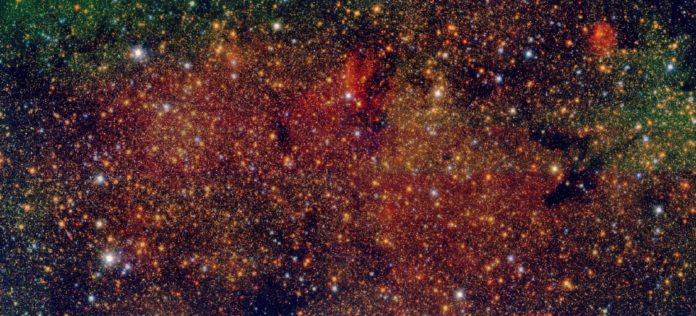Using detailed observations, astronomers managed to get a first representative glimpse of the star factory in the central region of the Milky Way. Here, the star factory is referred to as the numerous young stars. The observations suggest that star formation in the center of the Galaxy started first, then started working outwards.
Astronomers also found that most of the stars in that region did not originate in tightly-bound massive clusters but in loose stellar association, which dispersed over the past millions of years.
The Milky Way’s center volume is less than 1% compared to the galactic disk. More than 10% of all newborn stars in the Galaxy in the past 100 Myr formed there. Hence, it is considered a perfect laboratory to understand star formation under extreme conditions.
Astronomers have long hoped this could offer them a lab for researching rapid star formation, specifically during the earliest billions of years of cosmic history. But the crowding makes stars in the central region notoriously difficult to observe.
Thanks to this new analysis, astronomers could get the first representative reconstruction of star formation history in the Galactic central region based on a high-resolution infrared survey.
Learning about high-productivity star formation from our Galaxy’s central regions is challenging because these regions are notoriously difficult to observe. To begin with, as seen from Earth, they are hidden behind copious amounts of dust.
But that problem is readily solved using infrared, millimeter waves, or radio observations. The light passes through the dust at those wavelengths, offering a view of the Galactic Center. This is how astronomers performed their mind-boggling observations of stars orbiting our Galaxy’s central black hole (near-infrared) and how the Event Horizon Collaboration produced the first image of the shadow of our Galaxy’s central black hole (millimeter waves at 1.3 mm).
With the first issue resolved, the following one arises: it is challenging to distinguish one star from another at the Galactic Center due to its dense concentration of stars. A few bright gigantic stars are the exception; they are particularly luminous, stand out from the rest, and can thus be distinguished from the others quite readily. Astronomers have struggled with this issue for years as they try to understand the high star formation rate in the Galactic Center. The existence of hydrogen gas split into its components (ionized) by ultraviolet light from hot, newborn stars and the presence of X-rays characteristic of some types of young, very massive stars witness to the fact that such star formation occurred over the past one to ten million years.
But because of the crowding issue, it has been challenging to respond to the query, “So where are the resulting new stars, then?” Aside from two significant star clusters and a few lone young stars, astronomers had only discovered around 10% of the anticipated total stellar mass in the Galactic Center before the new analysis detailed here. So where were all the other stars, and what were their properties?
Astronomers, in this new analysis, asked themselves the same. As a part of the survey- GALACTICNUCLEUS- they set out to find the missing young stars in the Galactic Center. They used the HAWK-I infrared camera at the Very Large Telescope (VLT) of the European Southern Observatory to take nearly 150 pictures (in the infrared bands J, H, and Ks) of the Milky Way’s central region, covering a total area of 64,000 square light-years around the Galactic Center.
Astronomers analyzed the star formation history of Sagittarius (Sgr) B1, a Galactic center region associated with strong HII emission. They immediately saw that the region was different- containing considerably more young stars, which ionize the surrounding gas, than other regions – an effect that did not come as a surprise.
The astronomers could deduce each star’s brightness, compensating for dimming due to dust between us and a particular star. All of the stars in Sagittarius B1 are at about the same distance from Earth, and the distance from Earth to the Galactic Center is known; given that information, the astronomers were able to reconstruct each star’s luminosity – the intrinsic brightness, corresponding to the amount of light a star emits per unit time.
Astronomers also found- indeed, there had been several phases of star formation in Sagittarius B1: an older population that formed between 2 and 7 billion years ago and a large population of much younger stars, a mere 10 million years old or even younger than that.
Francisco Nogueras-Lara, an independent Humboldt research fellow in the Nadine Neumayer Lise Meitner group at the Max Planck Institute for Astronomy, said, “Our study represents a big step forward in finding the young stars in the Galactic Center. The young stars we found have a total mass of more than 400,000 solar masses. That is nearly ten times higher than the combined mass of the two massive star clusters previously known in the central region.”
It was mainly found that the stars found in Sagittarius B1 are dispersed. They were formed in one or more looser stellar associations, less tightly bound by the stars’ mutual gravity. And while this result refers to Sagittarius B1, to begin with, it could also explain much more generally why the young stars in the Galactic Center can only be found by high-resolution studies like the present work: they were born in loose associations that have since dispersed into separate stars.
Astronomers want to follow up their observations with the KMOS instrument at the VLT, a high-precision spectrograph. Spectral observations would allow them to identify some very young stars directly from the appearance of their spectra. That would be important to cross-check the results now published.
They are planning to track the motions of the newly-discovered stars in the sky (“proper motion”).
Journal Reference:
- Francisco Nogueras-Lara, Rainer Schödel, Nadine Neumayer. Detection of an excess of young stars in the Galactic center Sagittarius B1 region. Astrophysics of Galaxies. DOI: 10.48550/arXiv.2207.02227
